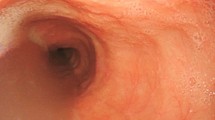Background:
It has been reported that esophageal achalasia is frequently associated with the dysmotility of other digestive organs. However, the prevalence of extraesophageal complications in patients with achalasia still remains poorly understood. We performed cholescintigraphy, using 99mTc-pyridoxyl-5-methyl-tryptophan, in patients with esophageal achalasia to assess any possible dysfunction of the sphincter of Oddi associated with achalasia. Methods: Eight patients (two men and six women) were examined to determine the time required for bile to flow from the bile duct to the duodenum. Results: Excretion time of bile was markedly prolonged in five of the eight patients with achalasia. Scintigraphic findings were not correlated with the radiographic classification of achalasia or with the grading of achalasia. Conclusions: The present results suggest that a considerable number of patients with achalasia have dysfunction of the sphincter of Oddi, irrespective of the morphological type of achalasia and the grade of esophageal dilatation.
Similar content being viewed by others
Author information
Authors and Affiliations
Additional information
Received: February 7, 2002 / Accepted: September 6, 2002
Reprint requests to: N. Uchida
Rights and permissions
About this article
Cite this article
Kobara, H., Uchida, N., Tsutsui, K. et al. Abnormal bile flow in patients with achalasia. J Gastroenterol 38, 327–331 (2003). https://doi.org/10.1007/s005350300059
Issue Date:
DOI: https://doi.org/10.1007/s005350300059




